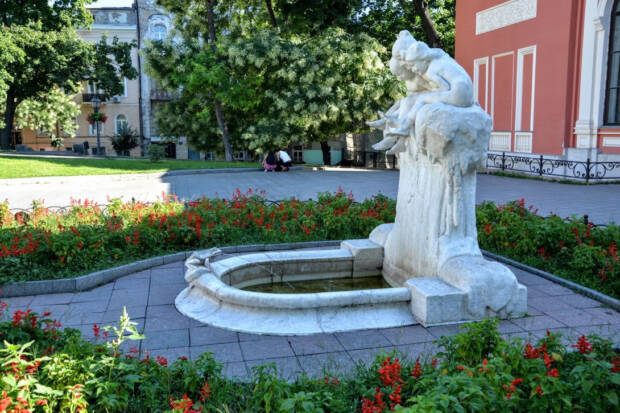Фонтан «Діти та жабеня»
Один з найвідоміших і естетично значущих пам’яток монументального мистецтва в центрі Одеси, фонтан «Молодість» представляє собою одну з рекомендованих копій скульптурної композиції французького скульптора епохи модерн Макса Блонда, звану одеситами «Діти і жаба» або «Нарцис».
Затребуваний французький скульптор Макс Блонда виставив мармурову скульптурну композицію-фонтан «Молодість» на Паризькому художньому салоні 1904 року. Робота користувалася успіхом, придбати її намагалися кілька покупців з різних країн Європи. Можливо, щоб задовольнити попит, скульптор домовився з покупцями про виготовлення реплік скульптурної групи.
Орієнтовно в ті (1905-1907) роки одна з скульптурних груп була придбана кимсь із заможних одеситів. За припущенням Олени Красновой і Анатолія Дроздовського скульптура спочатку була встановлена на території дачі Якима Біска, відомого на Півдні Росії ювеліра і батька поета і перекладача Олександра Біска. Биски володіли дачею за адресою Французький бульвар, 26, де згодом були зведені корпуси Одеського університету ім. Мечникова.
Після встановлення радянської влади нерухоме майно піддалося націоналізації. Ця доля спіткала і дачу Бисків.
Архітектор В. Трофименко в бібліографічному довіднику «Зодчі України кінця XVIII – середини XX століття» вказав, що скульптура-фонтан «Діти і жаби» була встановлена на Театральній площі в Одесі в 1925 році. На початку фонтан встановили в центрі Театрального саду (на довоєнних і післявоєнних фотографіях добре видно цей фонтан на тлі театру, розгорнутий до нього тильною стороною). У 1970-х роках композиція була переміщена впритул до будівлі Англійського клубу, в якому за радянських часів розташовувався Одеський Музей морського флоту. На цьому місці він знаходиться і до цього дня.
Children and the Frog Fountain
One of the most famous and aesthetically significant monuments of monumental art in the center of Odesa, the Youth Fountain is one of the recommended copies of the sculptural composition of the French modern sculptor Max Blonde, called Children and the Frog or Narcissus by Odesans.
The sought-after French sculptor Max Blonde exhibited the marble sculptural composition Fountain of Youth at the Paris Salon of 1904. The work was successful. Several buyers from different European countries tried to buy it. Perhaps, in order to satisfy demand, the sculptor agreed with buyers to produce replicas of the sculptural group.
Approximately in those (1905-1907) years, one of the sculptural groups was purchased by someone from wealthy Odesans. Olena Krasnova and Anatolii Drozdovskyi suggest that the sculpture was originally installed in the territory of Yakym Bisk’s dacha, a well-known jeweller in the South of Russia and the father of the poet and translator Oleksandr Bysk. The Bysk’s owned a dacha at 26 Frantsuzskyi Boulevard, where later the buildings of the Odesa University named after Mechnikov were erected.
After the establishment of Soviet power, real estate was nationalized. This fate also befell the Bysk’s dacha.
Architect V. Trofymenko indicated in the bibliography “Architects of Ukraine of the late 18th – mid-20th century” that the Children and Frogs sculpture fountain had been installed on Teatralna Square in Odesa in 1925. The fountain was initially installed in the center of Theater Garden (in the pre-war and post-war photographs, this fountain is clearly visible against the background of the theater, facing it from the back). In the 1970s, the composition was moved close to the building of the English Club, which in Soviet times housed the Odesa Naval Museum. It is in this place to this day.

